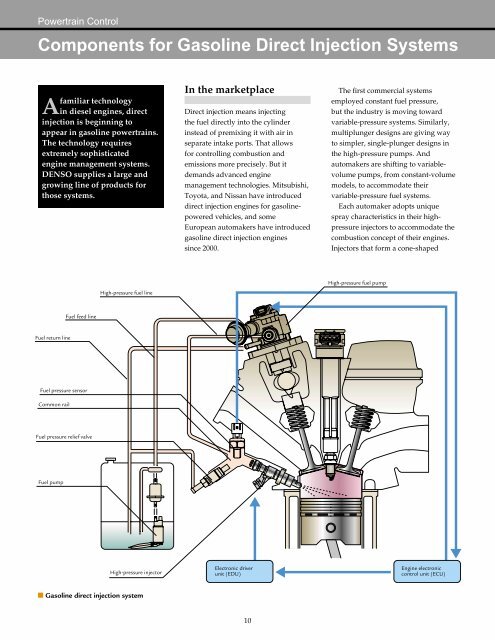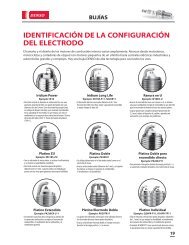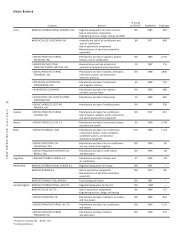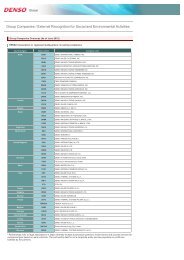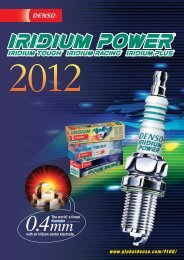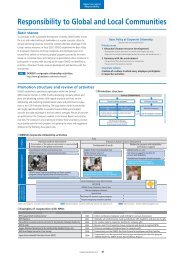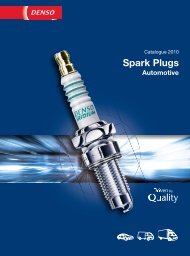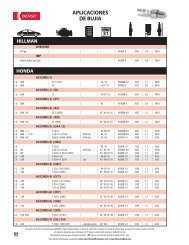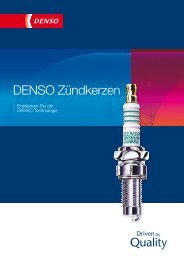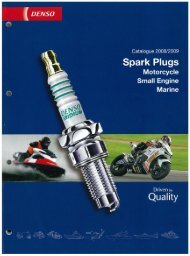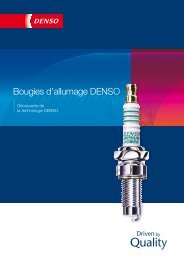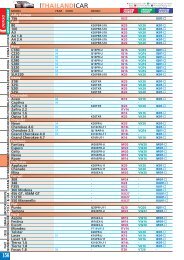Components for Gasoline Direct Injection Systems - Denso
Components for Gasoline Direct Injection Systems - Denso
Components for Gasoline Direct Injection Systems - Denso
You also want an ePaper? Increase the reach of your titles
YUMPU automatically turns print PDFs into web optimized ePapers that Google loves.
Powertrain Control<br />
<strong>Components</strong> <strong>for</strong> <strong>Gasoline</strong> <strong>Direct</strong> <strong>Injection</strong> <strong>Systems</strong><br />
Afamiliar technology<br />
in diesel engines, direct<br />
injection is beginning to<br />
appear in gasoline powertrains.<br />
The technology requires<br />
extremely sophisticated<br />
engine management systems.<br />
DENSO supplies a large and<br />
growing line of products <strong>for</strong><br />
those systems.<br />
Fuel return line<br />
Fuel feed line<br />
Fuel pressure sensor<br />
Common rail<br />
Fuel pressure relief valve<br />
Fuel pump<br />
High-pressure fuel line<br />
High-pressure injector<br />
■ <strong>Gasoline</strong> direct injection system<br />
In the marketplace<br />
<strong>Direct</strong> injection means injecting<br />
the fuel directly into the cylinder<br />
instead of premixing it with air in<br />
separate intake ports. That allows<br />
<strong>for</strong> controlling combustion and<br />
emissions more precisely. But it<br />
demands advanced engine<br />
management technologies. Mitsubishi,<br />
Toyota, and Nissan have introduced<br />
direct injection engines <strong>for</strong> gasolinepowered<br />
vehicles, and some<br />
European automakers have introduced<br />
gasoline direct injection engines<br />
since 2000.<br />
Electronic driver<br />
unit (EDU)<br />
10<br />
The first commercial systems<br />
employed constant fuel pressure,<br />
but the industry is moving toward<br />
variable-pressure systems. Similarly,<br />
multiplunger designs are giving way<br />
to simpler, single-plunger designs in<br />
the high-pressure pumps. And<br />
automakers are shifting to variablevolume<br />
pumps, from constant-volume<br />
models, to accommodate their<br />
variable-pressure fuel systems.<br />
Each automaker adopts unique<br />
spray characteristics in their highpressure<br />
injectors to accommodate the<br />
combustion concept of their engines.<br />
Injectors that <strong>for</strong>m a cone-shaped<br />
High-pressure fuel pump<br />
Engine electronic<br />
control unit (ECU)
spray are most common, though<br />
Toyota has begun using a fan-shaped<br />
spray.<br />
We began limited production of<br />
components <strong>for</strong> gasoline direct<br />
injection engines in 1996 and have<br />
been mass-producing them since 1997.<br />
In 2000, we supplied components <strong>for</strong><br />
about 120,000 gasoline direct injection<br />
engines. We strengthened our product<br />
line during the year by introducing<br />
lighter-weight, higher-per<strong>for</strong>mance<br />
components.<br />
Injector<br />
High-pressure pump<br />
Nozzle<br />
configuration<br />
Spray<br />
■ High-pressure injection<br />
Slit nozzle<br />
Front view Side view<br />
In comparison with<br />
competitors<br />
The low drive torque in our highpressure<br />
pumps is significantly lower<br />
than in competing products. And the<br />
single-plunger design makes the<br />
pumps smaller and less expensive<br />
than multiplunger models.<br />
Our slit nozzles produce the first<br />
fan-shaped spray in the automobile<br />
industry. And our experience in<br />
mass-producing both slit and swirler<br />
nozzles equips us to satisfy a full<br />
range of automakers’ needs.<br />
Combining components in hybrid<br />
ICs has simplified and reduced the<br />
size of our electronic driver units <strong>for</strong><br />
injectors. Our units are about 40%<br />
lighter than competing products.<br />
Electronic driver unit<br />
11<br />
Swirler nozzle<br />
Fan-shaped Cone-shaped<br />
Issues and outlook<br />
<strong>Gasoline</strong> direct injection can help<br />
reduce the environmental impact of<br />
internal combustion power. By 2005,<br />
we expect more than 20% of the<br />
gasoline-powered new vehicles sold<br />
in Japan to have direct injection.<br />
Reducing cost is a pressing issue in<br />
making direct injection available in a<br />
broadened range of vehicle models.<br />
We will cultivate economies of scale<br />
by standardizing component designs<br />
and installation methods <strong>for</strong> different<br />
engines.<br />
Technical highlights<br />
Our common rail circuits allow <strong>for</strong><br />
controlling the fuel-delivery amount<br />
to generate the fuel pressure required<br />
by the engine. Electronic control<br />
adjusts the amount of fuel delivery<br />
with reference to a fuel pressure<br />
sensor in the common rail.<br />
We use a single-plunger design in<br />
our high-pressure injection pumps to<br />
provide high volumetric efficiency at<br />
low drive torque and at low cost. Our<br />
pumps have a built-in electromagnetic<br />
control valve, and the control function<br />
varies the fuel-delivery amount by<br />
adjusting the timing of the drive<br />
pulses sent to the valve. The drive<br />
torque and pulsation inside the highpressure<br />
lines are minimal, since our<br />
pumps supply only as much fuel as<br />
the engine actually requires.<br />
Our high-pressure injectors are<br />
available with different nozzles <strong>for</strong><br />
different spray configurations. We<br />
offer a swirler nozzle to produce a<br />
cone-shaped spray and a slit nozzle<br />
<strong>for</strong> a fan-shaped spray. Ultraprecise<br />
machining helps ensure a fine, highquality<br />
spray. We optimize injector<br />
per<strong>for</strong>mance with electronic driver<br />
units that incorporate original ICs.


